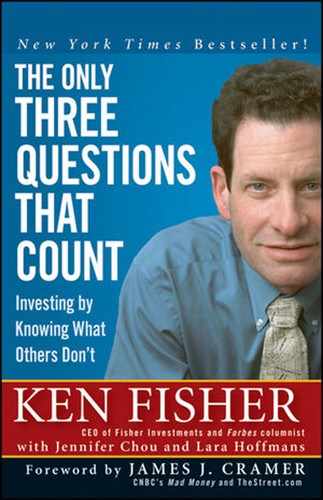Book Description
The Only Three Questions That Count is the first book to show you how to think about investing for yourself and develop innovative ways to understand and profit from the markets. The only way to consistently beat the markets is by knowing something others don't know. This book will show you how to do just that by using three simple questions. You'll see why CNBC's Mad Money host and money manager James J. Cramer says, "I believe that reading his book may be the single best thing you could do this year to make yourself a better investor.
In The Only Three Questions That Count, Ken Fisher challenges the conventional wisdoms of investing, overturns glib theories with hard facts, and blows up complacent beliefs about money and the markets. Ultimately, he says, the key to successful investing is daring to challenge yourself and whatever you believe to be true. Packed with more than 100 visuals, usable tools, and a glossary, The Only Three Questions That Count is an entertaining and educational experience in the markets unlike any other, giving you an opportunity to reap the huge rewards that only the markets can offer.
Table of Contents
- Copyright
- ACKNOWLEDGMENTS
- FOREWORD
- PREFACE
- 1. QUESTION ONE: WHAT DO YOU BELIEVE THAT IS ACTUALLY FALSE?
- 2. QUESTION TWO: WHAT CAN YOU FATHOM THAT OTHERS FIND UNFATHOMABLE?
- 3. QUESTION THREE: WHAT THE HECK IS MY BRAIN DOING TO BLINDSIDE ME NOW?
- 4. CAPITAL MARKETS TECHNOLOGY
- 4.1. Building and Putting Capital Markets Technology into Practice
- 4.2. It's Good while It Lasts
- 4.3. Forecast with Accuracy, Not Like a Professional
- 4.4. Better Living through Global Benchmarking
- 4.4.1. Your Benchmark Is a Road Map for Your Long Journey
- 4.4.2. Pick an Index, Any Index (but Don't Believe More Volatility Gets You Higher Returns)
- 4.4.3. Risk versus Return?
- 4.4.4. Global Thinking Equals Better Thinking
- 4.4.5. Never Say Dow
- 4.4.6. The Two-Stock Index
- 4.4.7. Never Maximize Return
- 4.4.8. The Greatest Risk of All
- 4.4.9. You Too Can Beat the Market
- 4.4.10. Emerging Markets and the GDP Myth
- 5. WHEN THERE'S NO THERE, THERE!
- 5.1. Johns Hopkins, My Grampa, Life Lessons, and Pulling a Gertrude
- 5.1.1. The Six Investment Life Lessons of Gertrude Stein
- 5.1.1.1. The Number Six Most Important Gertrude Stein Life Lesson
- 5.1.1.2. The Number Five Most Important Gertrude Stein Life Lesson
- 5.1.1.3. The Number Four Most Important Gertrude Stein Life Lesson
- 5.1.1.4. The Number Three Most Important Gertrude Stein Life Lesson
- 5.1.1.5. The Number Two Most Important Gertrude Stein Life Lesson
- 5.1.1.6. The Number One—All Time Most Important Gertrude Stein Life Lesson
- 5.1.2. Skip Oakland—Think Bird Flu
- 5.1.1. The Six Investment Life Lessons of Gertrude Stein
- 5.2. In the Center Ring—Oil versus Stocks
- 5.3. Sell in May because the January Effect Will Dampen Your Santa Claus Rally Unless There Is a Witching Effect
- 5.1. Johns Hopkins, My Grampa, Life Lessons, and Pulling a Gertrude
- 6. NO, IT'S JUST THE OPPOSITE
- 7. SHOCKING BUT TRUE
- 7.1. Supply and Demand . . . and That's It
- 7.2. Weak Dollar, Strong Dollar—What Does It Matter?
- 7.2.1. Five Myths and More Supply and Demand
- 7.2.1.1. Myth Number One—The Dollar Is Still Falling
- 7.2.1.2. Myth Number Two—The Budget Deficit Will Cause the U.S. Dollar to Fall
- 7.2.1.3. Myth Number Three—The Current Account Deficit Causes the Dollar to Fall
- 7.2.1.4. Myth Number Four—Currencies Are Determined by Trade Balances, Foreign Policy, International Popularity, and So On
- 7.2.1.5. Finally, Myth Number Five—A Weak Dollar Is Bad for Stocks
- 7.2.2. In Case You Forgot, Supply and Demand Determine Currency Prices
- 7.2.3. What Really Drives Currency Demand
- 7.2.4. Fear of a False Fact Is Bullish
- 7.2.1. Five Myths and More Supply and Demand
- 8. THE GREAT HUMILIATOR AND YOUR STONE-AGE BRAIN
- 9. PUTTING IT ALL TOGETHER
- 9.1. Stick with Your Strategy and Stick It to Him
- 9.2. Four Rules That Count
- 9.2.1. Rule Number One—Select an Appropriate Benchmark
- 9.2.1.1. The First Determinant—Time Horizon
- 9.2.1.2. Stocks or Bonds? The 929 Percent Question
- 9.2.1.3. The Second Determinant—Cash Flow
- 9.2.1.4. Homegrown Dividends
- 9.2.1.5. The Third Determinant—Return Expectation
- 9.2.1.6. The Fourth Determinant—Individual Peculiarity
- 9.2.1.7. Heat Chasing—To Shift or Not to Shift
- 9.2.2. Rule Number Two—Analyze the Benchmark's Components, Assign Expected Risk and Return
- 9.2.3. Rule Number Three—Blend Noncorrelated or Negatively Correlated Securities to Moderate Risk Relative to Expected Return
- 9.2.4. Rule Number Four—Always Remember You Can Be Wrong, so Don't Stray from the First Three Rules
- 9.2.1. Rule Number One—Select an Appropriate Benchmark
- 9.3. Finally! How to Pick Stocks That Only Win
- 9.4. When the Heck Do You Sell?
- CONCLUSION
- A. U.S. Equity Total Returns 1830 to 1925
- B. S&P 500 Composite Returns
- C. Simulated Technology Returns
- D. Nasdaq Composite Returns
- E. U.K. Stock Market Total Returns
- F. U.K. Stock Market (FTSE All-Share) Total Returns
- G. Germany Stock Market Returns
- H. Germany Stock Market (DAX) Total Returns
- I. Japan Stock Market Total Returns
- J. Japan Stock Market (TOPIX) Total Returns
- K. Fisher Investments Global Total Return Performance
- L. Ten-Year History of the Forbes Report Card
- M. The United Deficits: Data
- NOTES
- GLOSSARY
